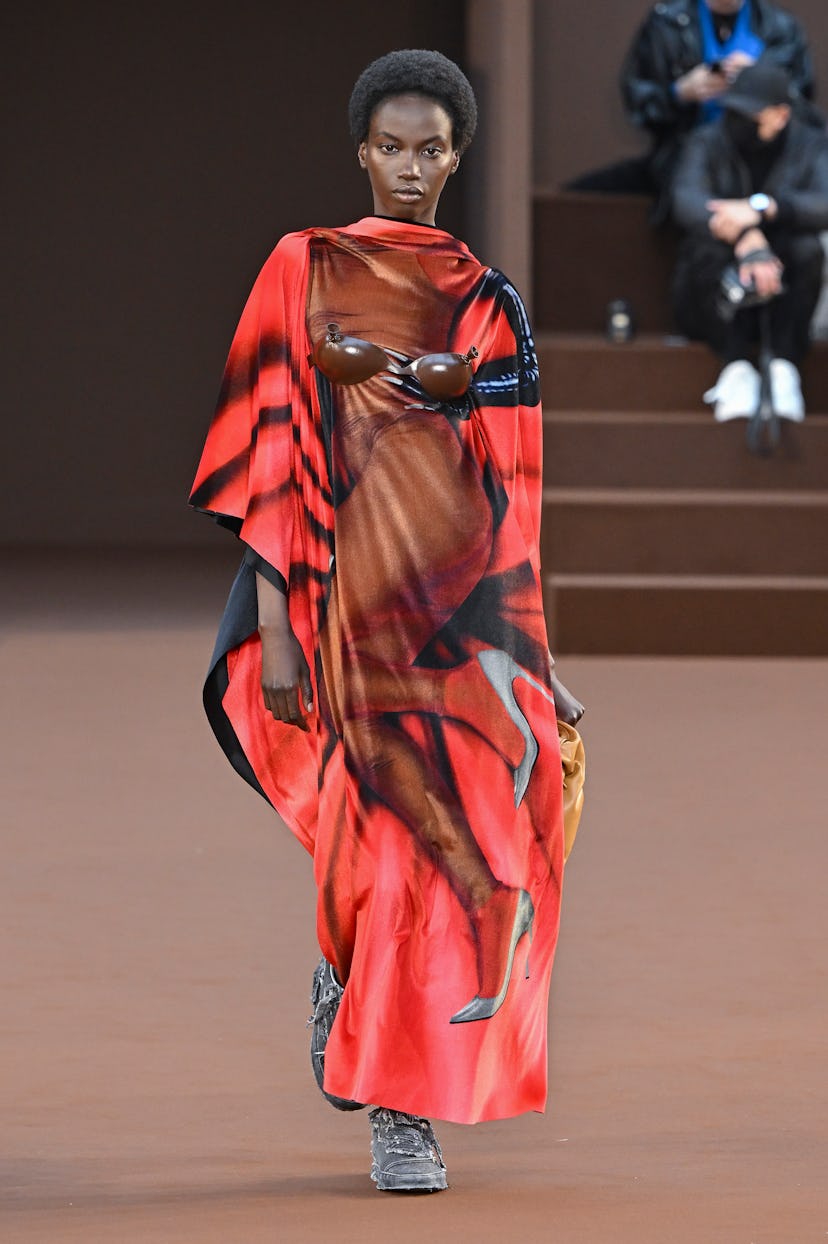Loewe’s Wacky, Wild World Is Just What Fashion Needs

British artist Anthea Hamilton’s massive pumpkin sculptures sitting in the middle of Loewe’s Paris Fashion Week runway sent a clear message: this collection was all about wild juxtapositions and surreal realities.
What followed was a continuation of the brand’s seismic shift into extremes—seen last season in the form of armor-like shapes and gilded breastplates. For fall 2022, there were automobile shapes outlined into dress hems, high-heel shoes under gauzy layers of mesh, hyper-real lips or rose buds cemented into the busts of dresses, with sheer fabric trailing underneath. Elsewhere, surreal touches flickered throughout the collection in the details, such as 3-D shiny balloons (they covered balloon-printed dresses on the bust as makeshift bras). They could be seen again on rich jewel-tone dresses outlined with the shape of the body, giving a very trompe l’oeil effect.
A draped black dress had the same 3-D upturned balloons in fleshy hues scattered all over it. From far away, it might have looked like breasts, or even flashes of skin. But that’s sort of the point with Jonathan Anderson’s Loewe lately—which seems to be akin to what the original Surrealists offered up when the movement first started in the 1920s. Back then, Surrealism was prompted by a reaction to the so-called rational logic and ideas believed to have started World War I. The Surrealists wanted to fight against this “rationalism” that they believed guided European culture and politics into war—thus turning reality into fantasy, or “an absolute reality, a surreality,” in the words of poet and critic André Breton, who published The Surrealist Manifesto in 1924.
Photo by Victor VIRGILE/Gamma-Rapho via Getty Images
Surrealists also drew from the work of neurologist Sigmund Freud, using words and visuals to expand all possibilities between dreams and reality. The aim was to tap into the unconscious imagination as a way to rethink daily life. In 2022, when Russia has waged war upon Ukraine and a certain amount of uncertainty about the future of the ongoing pandemic still exists, it’s no wonder this escapist concept may have inspired Jonathan Anderson for fall. Plus, all that detached anatomy—from lips to the outline of arms and hands—were easily referential to Salvador Dalí, René Magritte or the original surrealist fashion designer herself, Elsa Schiaparelli.
Anderson put a focus on garments with less of an extreme appeal, too. Continuing to experiment with bulky lines and chunky shapes (both seen in past seasons at Loewe and his namesake label, J.W. Anderson), we saw sweaters with raised circular collars like pillows, and flowing robe-like cardigans with padded sleeves.
Oversized outerwear came draped over the shoulders in odd yet appealing directions and minimal colors. Neutral-hued trousers had upturned waistbands done in fur; ripe with references, unintentional or not, to Meret Oppenheim’s famous fur teacup. And even though we’ve seen bits and pieces of these techniques before, as in the expanded chunky lines and armor-like sculpted tops, Loewe’s fall collection still felt new and relevant.
That idea of making something “normal,” like fashion, strange again? It feels as essential as water during times like these.